Osteoporosis Risk Assessment Tool
Understanding Your Risk Level
Low Risk
Minimal risk factors. Continue maintaining healthy habits.
Moderate Risk
Some risk factors present. Consider lifestyle improvements.
High Risk
Multiple risk factors. Consult your doctor for screening.
Bone health often goes unnoticed until something goes wrong. Osteoporosis is a condition where bones become fragile and more likely to break, affecting millions worldwide. This guide breaks down what leads to the disease, how you might spot it, and what you can do to lower your chances of ending up with a broken hip or a painful fracture.
Quick Takeaways
- Osteoporosis weakens bone structure, making fractures common.
- Key causes include age‑related hormone changes, low calcium/vitaminD, and certain medications.
- Silent symptoms-often no pain until a fracture occurs-make early screening vital.
- Risk factors fall into non‑modifiable (age, sex, genetics) and modifiable (diet, lifestyle, meds) groups.
- Weight‑bearing exercise, adequate nutrition, and regular bone‑density tests can dramatically cut risk.
What Exactly Is Osteoporosis?
In simple terms, osteoporosis means the bone’s internal scaffolding-called bone mineral density (BMD)-has thinned out. Healthy bone constantly remodels: old cells break down, new cells build back up. With osteoporosis, the breakdown outpaces the rebuilding, leading to porous, weaker bone.
How Bones Lose Strength: The Main Causes
Understanding the “why” helps you tackle the problem head‑on. Here are the biggest contributors:
- Hormonal shifts - After menopause, estrogen drops sharply. Estrogen helps protect bone, so its loss speeds up bone loss. Men also lose testosterone with age, which can affect bone density, though usually later in life.
- Calcium deficiency - Calcium is the main mineral in bone. Diets low in dairy, leafy greens, or fortified foods leave the skeleton short‑changed.
- Insufficient vitaminD - VitaminD helps the gut absorb calcium. Without enough sun exposure or vitaminD‑rich foods, calcium stays in the bloodstream instead of cementing bone.
- Long‑term corticosteroid use - Meds like prednisone blunt bone‑forming cells and boost bone resorption, especially when taken for months or years.
- Unhealthy lifestyle - Smoking harms blood flow to bone tissue, while excessive alcohol (more than three drinks a day) interferes with bone‐building cells.
- Physical inactivity - Bones need mechanical stress to stay strong. Sedentary living, especially without weight‑bearing activities, accelerates bone loss.
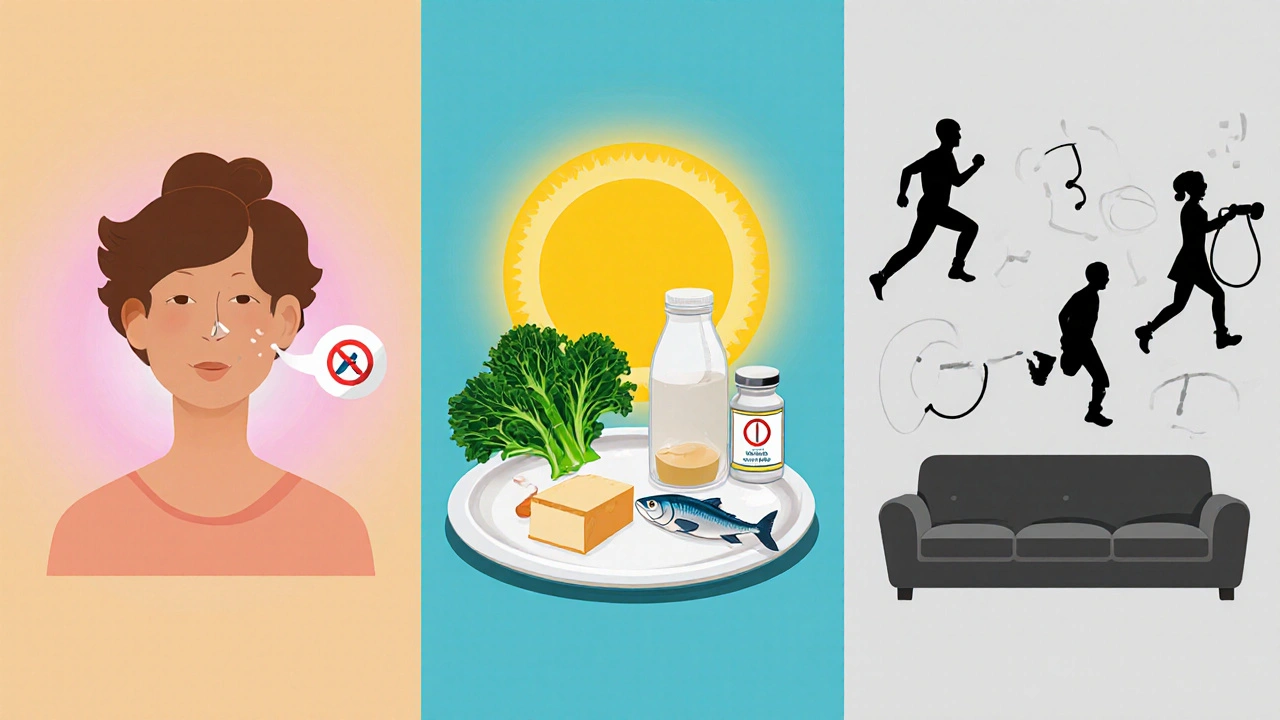
Spotting the Signs: Symptoms to Watch For
Osteoporosis is often called a “silent disease” because most people feel fine until a fracture occurs. Still, there are clues:
- Loss of height-typically a half‑inch or more over several years.
- Stooped posture or a “dowager’s hump” due to vertebral compression fractures.
- Back pain that doesn’t improve with rest or typical treatments, hinting at a cracked vertebra.
- Fractures from low‑impact events-like a bump in the closet or a minor fall.
If you notice any of these, talk to a doctor promptly. Early detection can prevent a cascade of fractures.
Who’s Most at Risk? Breaking Down Risk Factors
Risk factors split into two buckets. Understanding which apply to you helps you decide on screening frequency and preventive actions.
| Category | Risk Factor | Impact on Bone Health |
|---|---|---|
| Non‑modifiable | Age (women >65, men >70) | Loss of hormonal protection and slower bone formation. |
| Non‑modifiable | Sex (female) | Lower peak bone mass and menopause‑related estrogen drop. |
| Non‑modifiable | Family history | Genetic traits affect bone density and remodeling rates. |
| Modifiable | Low calcium/vitaminD intake | Insufficient mineral supply for bone maintenance. |
| Modifiable | Smoking | Reduces blood flow, accelerates bone loss. |
| Modifiable | Excess alcohol | Disrupts osteoblast activity. |
| Modifiable | Physical inactivity | Lack of mechanical loading weakens bone. |
| Modifiable | Long‑term corticosteroid therapy | Directly suppresses bone formation. |
Note that you can’t change age, sex, or genetics, but you can control diet, exercise, and medication habits.
Cutting Your Risk: Practical Prevention Tips
Here’s a straightforward checklist you can start using today:
- Boost calcium intake to 1,200mg daily for women over 50 and 1,000mg for men. Good sources: dairy, fortified plant milks, sardines, and kale.
- Aim for 800-1,000IU of vitaminD each day. Sun exposure (10‑15minutes a few times a week) plus foods like salmon, eggs, and fortified cereals helps.
- Engage in weight‑bearing exercise at least three times a week-think brisk walking, dancing, or resistance training with bands or light weights.
- Quit smoking. If you need help, talk to a healthcare provider about nicotine replacement or counseling.
- Limit alcohol to no more than two drinks for men and one for women per day.
- Review your medication list with a doctor. If you’re on steroids, ask about the lowest effective dose or alternative treatments.
- Schedule a bone‑density test-called a DXA scan-if you’re over 65 (or younger with risk factors).
Following these steps can preserve bone mass and keep you moving without fear of a surprise fracture.
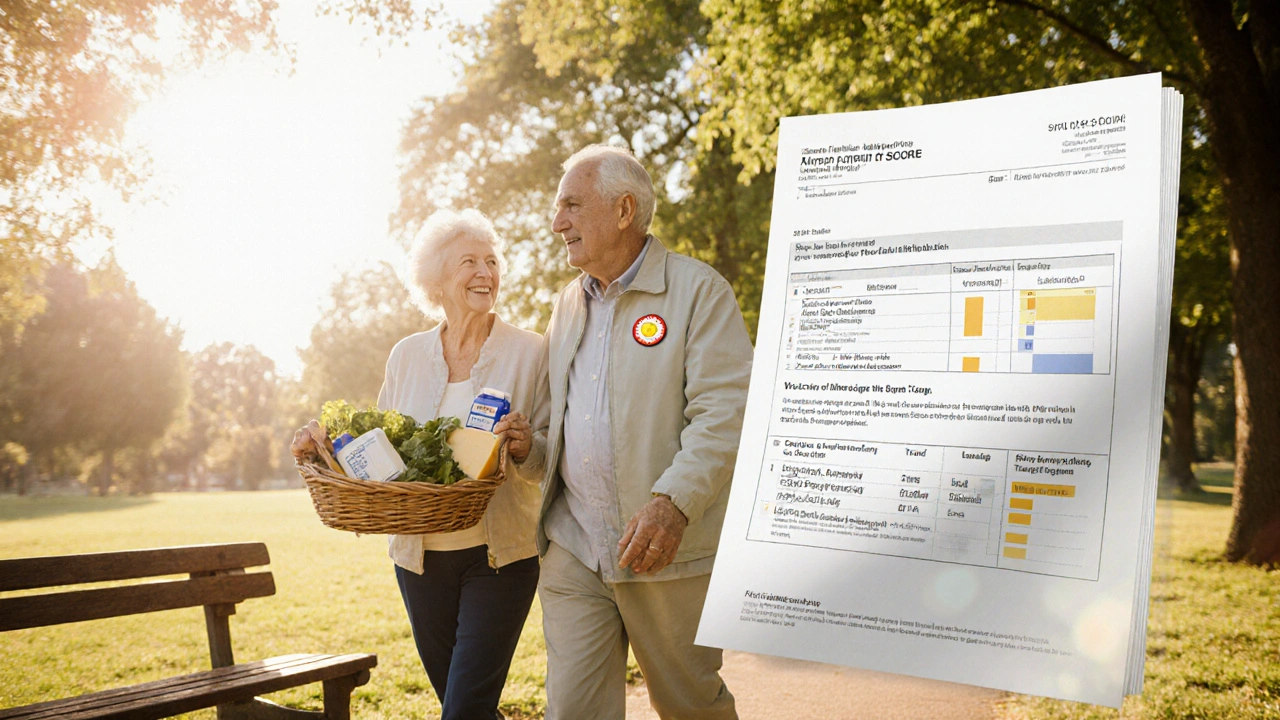
When to Get Checked: Diagnosis and Screening Tools
Screening is the bridge between risk awareness and action. The gold standard is the dual‑energy X‑ray absorptiometry (DXA) scan, which measures BMD at the hip and lumbar spine. Results are reported as a T‑score:
- T‑score≥‑1.0 → Normal bone density.
- T‑score between ‑1.0 and ‑2.5 → Osteopenia (low bone density, higher fracture risk).
- T‑score≤‑2.5 → Osteoporosis.
For those with multiple risk factors, doctors may also use the FRAX tool, which estimates a 10‑year probability of hip or major osteoporotic fracture based on age, sex, weight, previous fracture, and lifestyle factors.
Living with Osteoporosis: Management and Treatment Options
If you’ve already been diagnosed, you’re not powerless. Treatment focuses on halting bone loss, rebuilding bone, and preventing fractures.
- Medications - Bisphosphonates (e.g., alendronate) are first‑line drugs that slow bone breakdown. Other options include denosumab, selective estrogen receptor modulators, and parathyroid hormone analogs for severe cases.
- Calcium & vitaminD supplementation - Often prescribed to ensure the body has the raw material needed for bone repair.
- Physical therapy - Tailored exercise programs improve balance, strengthen the back and hips, and reduce fall risk.
- Fall‑proofing your home - Install grab bars, remove loose rugs, and use non‑slip mats in bathrooms.
Regular follow‑up appointments, typically every 1‑2years, let doctors monitor BMD changes and adjust treatment plans.
Frequently Asked Questions
Can men get osteoporosis?
Yes, men develop osteoporosis, usually after age 70. Though women are at higher risk because of menopause, men with low testosterone, chronic steroid use, or a family history should also be screened.
Is osteoporosis reversible?
While you can’t fully restore peak bone mass, treatments and lifestyle changes can increase bone density and dramatically lower fracture risk.
How often should I get a DXA scan?
For women over 65 and men over 70, a scan every two years is typical. If you have multiple risk factors, your doctor may recommend annual testing.
Can diet alone prevent osteoporosis?
Diet is a cornerstone-adequate calcium and vitaminD are essential-but exercise, medication (if needed), and avoiding harmful habits complete the preventive picture.
What symptoms signal a fracture due to osteoporosis?
Sudden back pain, inability to bear weight on a limb after a minor fall, or a noticeable change in height can indicate a fracture. Seek medical care immediately.
Understanding osteoporosis equips you to act before a silent bone loss becomes a painful break. By recognizing causes, watching for symptoms, and tackling modifiable risk factors, you can keep your skeleton strong for decades to come.

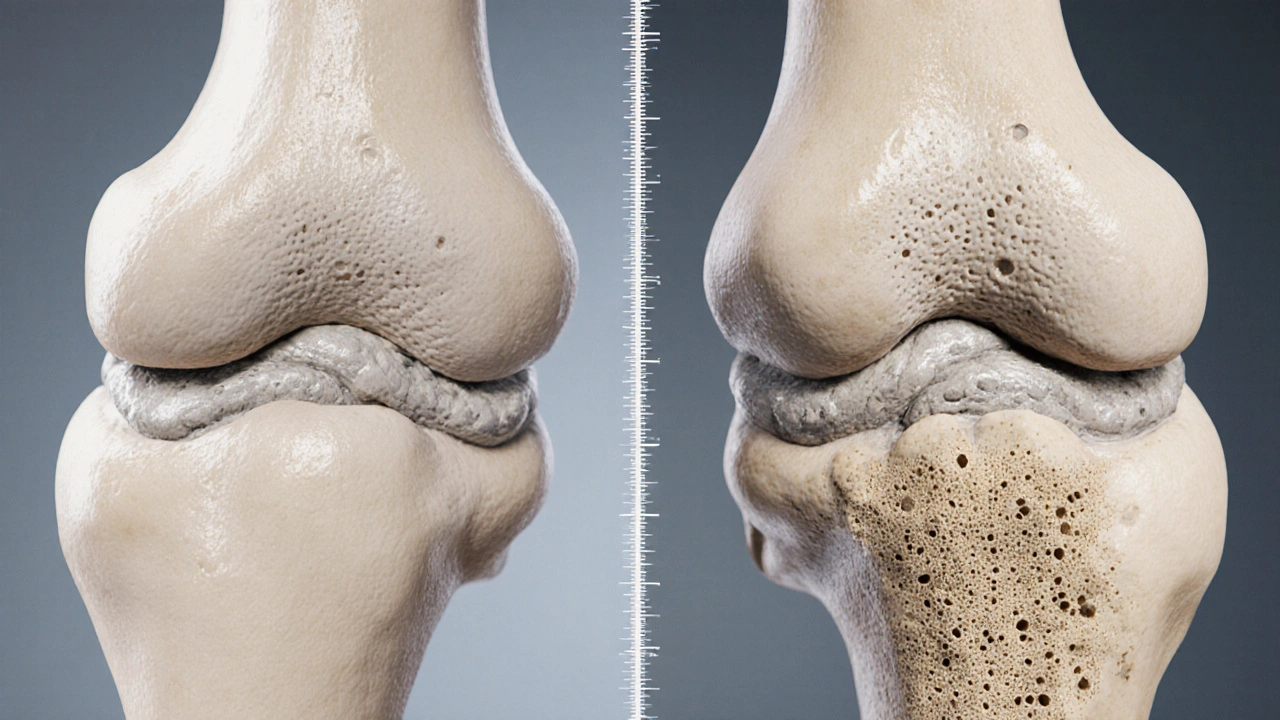
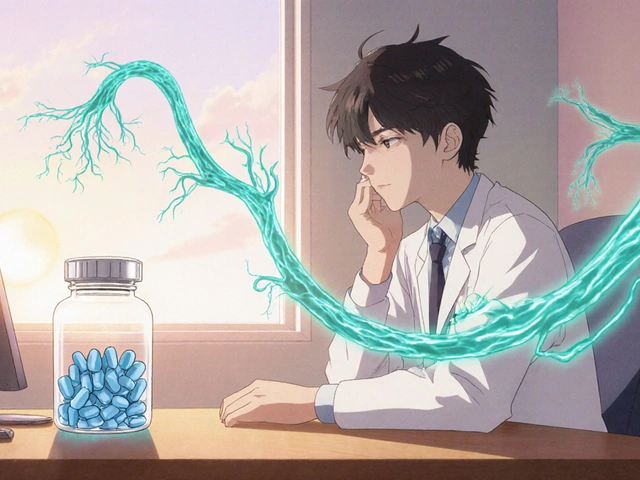

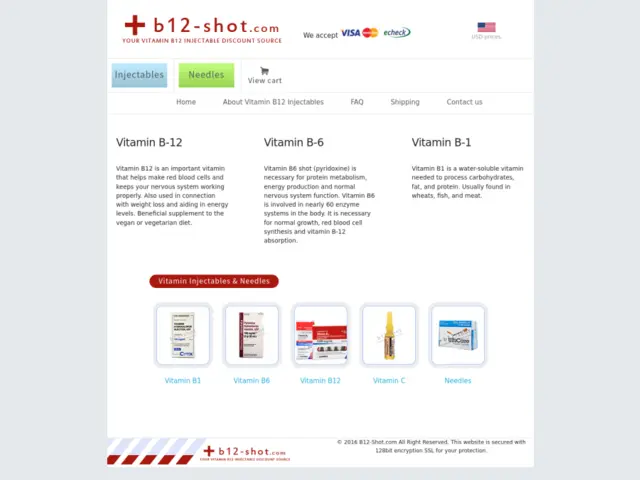
Ujjwal prakash - 10 October 2025
Wow, you really think a simple checklist will stop bone loss?; That’s naive, because osteoporosis isn’t just a lifestyle choice; it’s a complex metabolic disorder!; You need to understand hormonal changes, genetics, and the pharmacology of bisphosphonates before giving advice!!!
Diane Helene Lalande - 14 October 2025
Great summary of the risk factors; the practical tips are easy to follow and could help many people stay healthy.
Edwin Levita - 18 October 2025
Oh, behold the grand tapestry of bone decay laid before us! The sheer tragedy of calcium slipping through our veins like sand through an hourglass-how dramatically poetic, yet dreadfully fatal for the unsuspecting.
Xander Laframboise - 20 October 2025
While the prose may be theatrical, the evidence is crystal clear: sedentary habits and excessive alcohol are the real culprits, not some mystical bone‑sapping demon.
Jason Petersen - 23 October 2025
skip the fluff just get a scan.
Melissa Gerard - 26 October 2025
Sure, “just drink some milk” and all your problems vanish 🙄. Reality check: most people need more than a glass of dairy to meet their calcium needs.
Cindy Knox - 27 October 2025
Let’s not dismiss the struggle-every fracture is a personal nightmare, and the journey to recovery can feel like climbing a mountain without a rope.
beverly judge - 30 October 2025
For anyone unsure where to start, aim first for 1,200 mg of calcium daily and 800 IU of vitamin D; talk to your doctor about supplements if diet falls short, and consider a weekly weight‑bearing walk.
kevin joyce - 2 November 2025
From a biomechanical perspective, osteoclastic resorption outpaces osteoblastic formation when mechanical loading is insufficient; thus, integrating plyometric stimuli can recalibrate the RANK‑L/OPG axis, fostering net anabolic activity.
michael henrique - 5 November 2025
Our nation’s health depends on strong bones; if you’re not protecting yours, you’re betraying your patriotism-get screened, lift heavy, and eat right.
Jamie Balish - 10 November 2025
First, let’s acknowledge that osteoporosis is often called the “silent thief” because it progresses without obvious symptoms until a fracture occurs, which can be devastating both physically and emotionally.
Second, the risk assessment tool presented is a commendable effort to empower individuals, yet it simplifies a multifactorial disease into a handful of variables, which, while user‑friendly, may overlook nuances such as secondary causes like hyperthyroidism or chronic kidney disease.
Third, the dietary recommendations are solid: 1,200 mg of calcium and adequate vitamin D are essential, but many people have malabsorption issues, so serum 25‑OH vitamin D testing can be a valuable adjunct.
Fourth, exercise is not a one‑size‑fits‑all; weight‑bearing activities like walking are good, but resistance training with progressive overload yields superior improvements in bone mineral density, especially when targeting the hip and lumbar spine.
Fifth, smoking cessation and alcohol moderation are non‑negotiable-both directly impair osteoblast function and increase osteoclast activity, accelerating bone loss.
Sixth, the mention of corticosteroid use is crucial; chronic glucocorticoid therapy is one of the most potent iatrogenic risk factors, and patients on these meds should be monitored closely with periodic DXA scans.
Seventh, the FRAX tool, referenced briefly, offers a 10‑year probability estimate that can guide treatment thresholds, particularly in borderline cases.
Eighth, while the article highlights bisphosphonates as first‑line, newer agents like denosumab or romosozumab may be appropriate for those intolerant of oral therapies, and they have distinct mechanisms worth discussing.
Ninth, the psychological impact of a fracture-especially vertebral compression-is often underappreciated; chronic pain and loss of independence can lead to depression, which further reduces activity levels, creating a vicious cycle.
Tenth, fall‑proofing the home environment is practical advice, but educating patients on balance training and vision correction can markedly reduce fall risk.
Eleventh, regular follow‑up every one to two years ensures that therapeutic efficacy is assessed and adjustments are made, preventing complacency.
Twelfth, the article could benefit from a clearer distinction between osteoporosis and osteopenia; the latter is a warning sign that merits early intervention before a full‑blown fracture occurs.
Thirteenth, considering the global burden-over 200 million people are affected worldwide-public health initiatives that promote bone health from adolescence are essential.
Fourteenth, community programs offering free or low‑cost DXA scans can improve screening rates in underserved populations.
Fifteenth, overall, this piece provides a solid foundation, but integrating more personalized risk stratification and emerging therapies would elevate it from good to excellent.
Jeff Bellingham - 13 November 2025
While the content is accurate, the presentation is overly simplistic and fails to address the complexities of pharmacologic management in a rigorous academic manner.
Matthew Balbuena - 17 November 2025
Yo, this post is lit! But remember, you gotta keep your diet on point and hit the gym, otherwise those bones gonna be weak as a noodle.